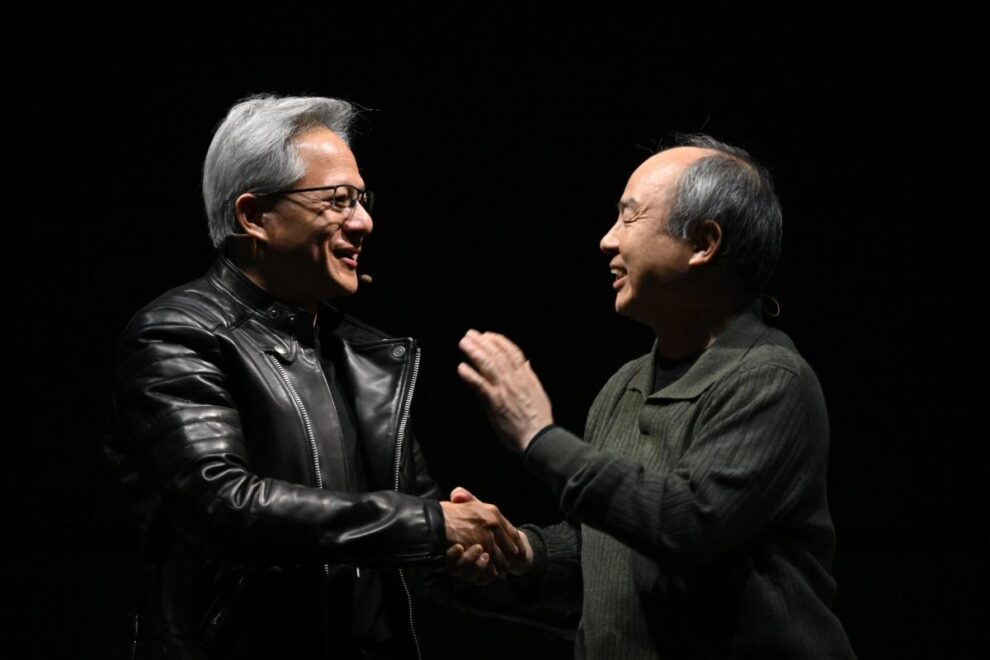
(Bloomberg) — SoftBank Group Corp. will be the first to build a supercomputer with chips using Nvidia Corp.’s new Blackwell design, a demonstration of the Japanese company’s ambitions to catch up on AI.
Most Read from Bloomberg
SoftBank’s telecom unit plans to build Japan’s most powerful AI supercomputer to support a wide range of local services, the two companies said. That computer will be based on Nvidia’s DGX B200 product, which combines computer processors with so-called AI accelerator chips. A follow-up effort will feature Grace Blackwell, a more advanced version.
Shares of SoftBank Corp., Japan’s No. 3 wireless carrier, reversed losses and rose 1% Wednesday. SoftBank Group, which comprises the conglomerate’s investment teams, fell 1.7%.
Nvidia’s chips have become a prized commodity for the world’s biggest tech companies, which use the components to develop and run AI models. The process requires software to be bombarded with data — something accelerator chips are especially adept at handling.
The announcement indicates that SoftBank, which until early 2019 owned 4.9% of Nvidia, has secured a favorable spot in line for the chips. SoftBank founder Masayoshi Son has said he’s preparing to ‘swing for the fences’ in AI bets. On Tuesday, the company reported a return to profitability on rising tech valuations.
Nvidia Chief Executive Officer Jensen Huang had announced the new Blackwell lineup earlier this year, but production snags slowed the rollout. Though Huang has said that supplies will be plentiful once manufacturing ramps up, customers have been eager to get their hands on the first new chips.
Son joined Huang on stage in Tokyo during Nvidia’s AI Summit Wednesday. When reminded of SoftBank’s prior Nvidia stake — which would be worth around $178 billion today — Son cringed and laughed, then wrapped Huang in a bear hug.
Nvidia has been crisscrossing the globe to host such events, promoting what it calls the new industrial revolution. Events in India and now Japan are aimed at broadening the deployment of AI systems to nation-based efforts and lessening Nvidia’s reliance on a few large US customers.
In addition to the new computer and the plan for a second, SoftBank’s telecom unit will also use Nvidia gear to provide AI services over cellular networks. Traditional hardware, based on custom chips that are designed to maximize mobile data traffic, aren’t optimal for new AI services.
“What will result is an AI grid that runs across Japan,” Huang said, adding that this would change the communications network into an AI network.
New AI-RANs, or AI radio access networks, will be better-suited to remote robotics, autonomous vehicle support and powering other services, Huang said. They’ll also require less electricity.
The telecom unit will begin testing the network with partners Fujitsu Ltd. and International Business Machines Corp.’s Red Hat.
“We are going to buy a lot of your chip,” Son told Huang.
Japan is on the cusp of change, said the Japanese billionaire, who’s often criticized both the country’s government and companies for their slowness in adopting new technologies. This time, the Japanese government is not getting in the way of a buildout in AI and robotics, he said.
The Japanese government has allocated ¥4 trillion ($26 billion) to bolster its domestic chip production capacity. That includes a moonshot project behind Rapidus Corp. to build a state-of-the-art foundry from scratch to challenge Taiwan Semiconductor Manufacturing Co., which manufactures Nvidia chips. Prime Minister Shigeru Ishiba has also pledged more than $65 billion of fresh support for the nation’s semiconductor and AI sectors.
“But they should encourage more,” Son told Huang. “As you say, this is the reset, this is the catch up moment for this revolution. We can’t miss this time.”
–With assistance from Edwin Chan.
(Updates with background and comments)
Most Read from Bloomberg Businessweek
©2024 Bloomberg L.P.






